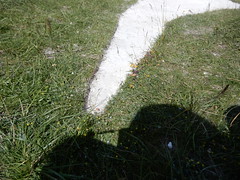My Mum's husband's birthday treat this year was hammering the horse at Uffington (you also find it called chalking or scouring) which is done every year to keep it white and shiny and well defined (except during world wars when it is reverently covered with turfs to keep it safe and disguise the landmark). He's an archaeologist, so taking part in a public custom that's been running for thousands of years (they took cores to check) is his bread and butter, but I also fancied the idea, so we went to join them. Here we are, chalking up the horse:

It was a hot, hot day, and as I worked along with the other volunteers, the soft tump-tump-tump of the hammers and the skylarks singing, and the flowers and the butterflies all got me thinking. Were we not gardening?
In a place like that, could you resist scouring and chalking your way to an green and white op-art garden of wonder?




Chalk grasslands are rich with flowers and butterflies. It's a stunning biome, though exposed and too far from water, shelter, roads, and so on to see many houses, many gardens.


Working farm trails and roads feature; spaces where trees have taken the land to create hedge spaces, clearings and copses. Wayland's Smithy is just down the road here, with its gentle lawn and extraordinary rocks, its woodland and wildflower borders.





It was a hot, hot day, and as I worked along with the other volunteers, the soft tump-tump-tump of the hammers and the skylarks singing, and the flowers and the butterflies all got me thinking. Were we not gardening?
We talked it over; was it more akin to public art, a social act like a barn raising or laying a new road? The thin chalk lines that went down through the centuries became steadily more defined. Not many people live in chalk uplands, but in the village I grew up in there were the occasional properties where you'd cut the turf with a spade and hit chalk, almost at the surface.




Chalk grasslands are rich with flowers and butterflies. It's a stunning biome, though exposed and too far from water, shelter, roads, and so on to see many houses, many gardens.


Working farm trails and roads feature; spaces where trees have taken the land to create hedge spaces, clearings and copses. Wayland's Smithy is just down the road here, with its gentle lawn and extraordinary rocks, its woodland and wildflower borders.




No comments:
Post a Comment